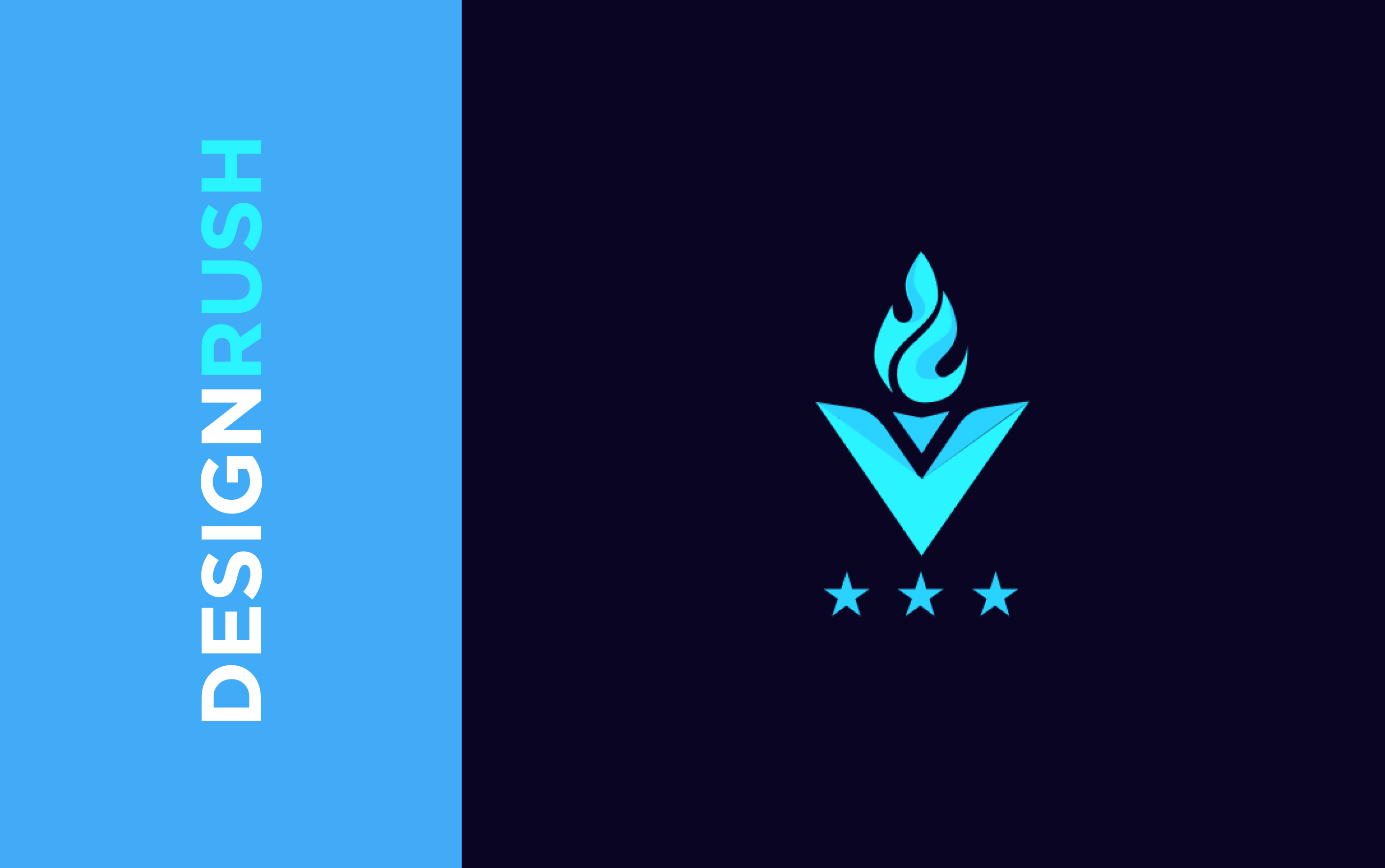What if there were no routines in the HR process? Or what if you could hire faster and better? Implementing the human resource management system can answer these.
“The way people experience your organization matters. 49% of people say they have turned down a job at an organization because of a bad recruiting experience. Furthermore, 56% of people say that they would actively discourage others from applying for a job at a company due to a bad recruiting experience.” Dan Staley, Principal, HR Technology Leader, PwC
Implementing a human resources management system can solve these challenges even more. Many companies invest in HRMS software development to make the recruiting experience smoother and more effective. According to Statista, 47% of large organizations already possessed human resources management systems in 2019, while 74% of companies who responded to PwC’s HR Technology Survey planned to increase HR tech spending in 2020.
At Axicube, we have good experience creating custom solutions for different businesses needs. For example, there is our collaboration with Yangol - an employee onboarding system. An employee onboarding system is a branch of HRMS software solutions. Read our case study about it to see how we’ve coped with this task.
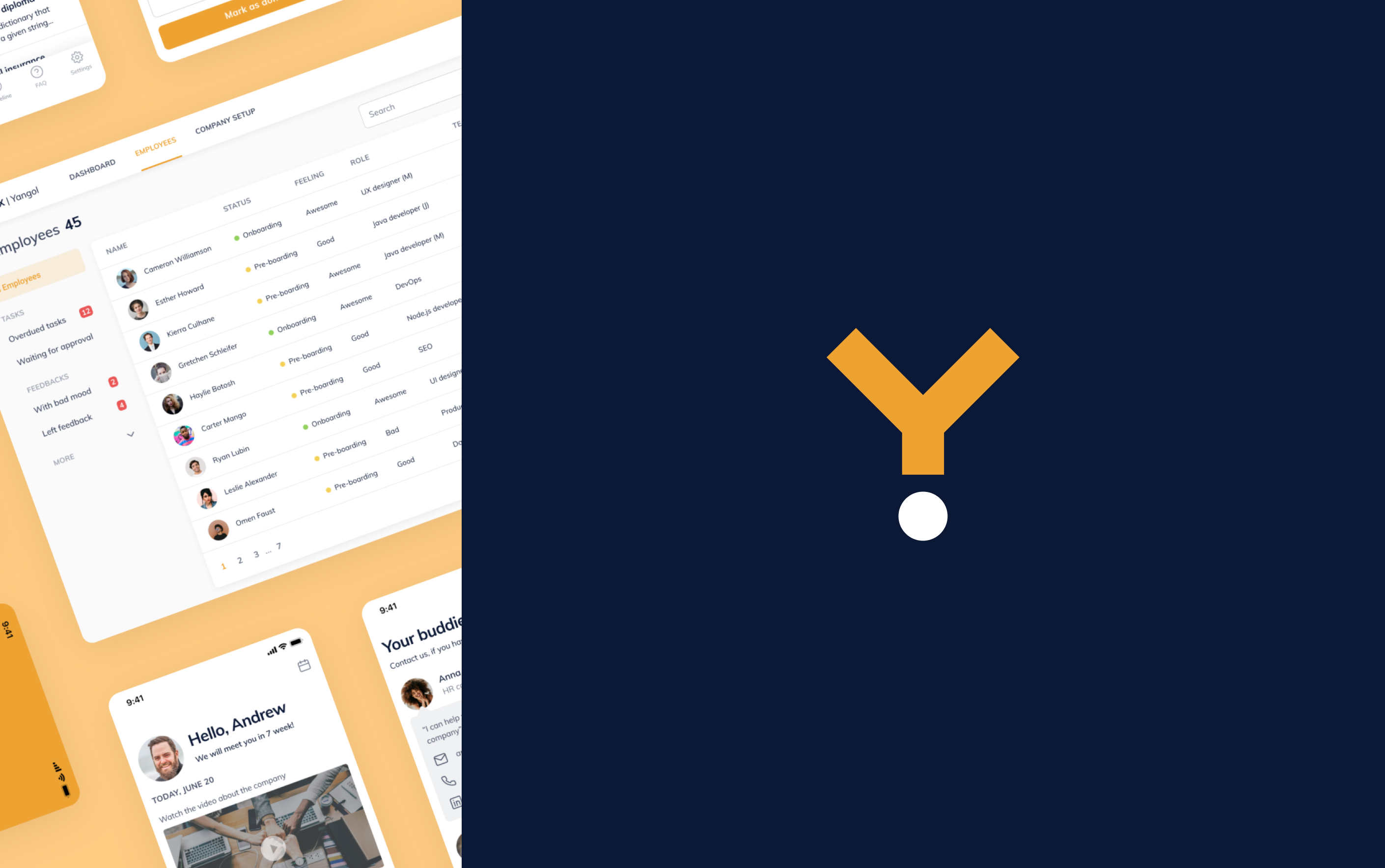
How to Improve Employee Onboarding with Yangol.io | Case Study
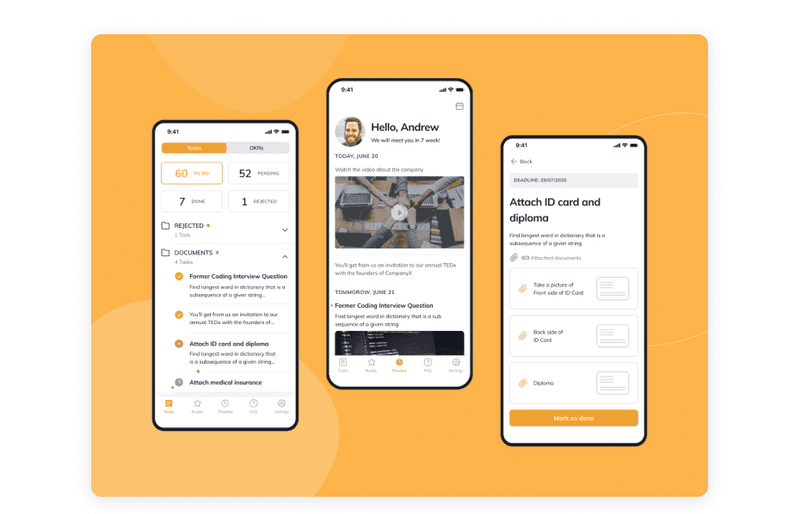
Dribbble shot by Axicube
This article will explain how to create a human resources management system. But first, let’s find out what HRMS software is and how it can improve the performance of your employees, in particular the HR department, and therefore how it can take your business to the next level.
What is HR System
To better understand, let’s start with definitions. Human Resource Management (HRM) is a widely accepted term for all the human resources departments’ activities. These activities include recruitment, payroll, management, etc. It is also an ideology that sees employees as resources that need to be managed effectively so that companies can get the most out of them.
Okay, now we understand what HRM is. But what about HR system software? The Human Resource Management System (HRMS) is a software solution for mid-size or large-sized companies to automate personnel management.
HR solutions usually consist of a few components. These are core HR, workforce management, recruitment management, applicant tracking tools, learning management, and reports and analytics features. They offer all HR management tools that the human resources department needs to improve employee performance. You don’t need to include all your employment information system components if your company doesn’t need some of them. However, you can add them later.
There is also an HR software development for small businesses. However, they usually have different features than software for medium and large companies.
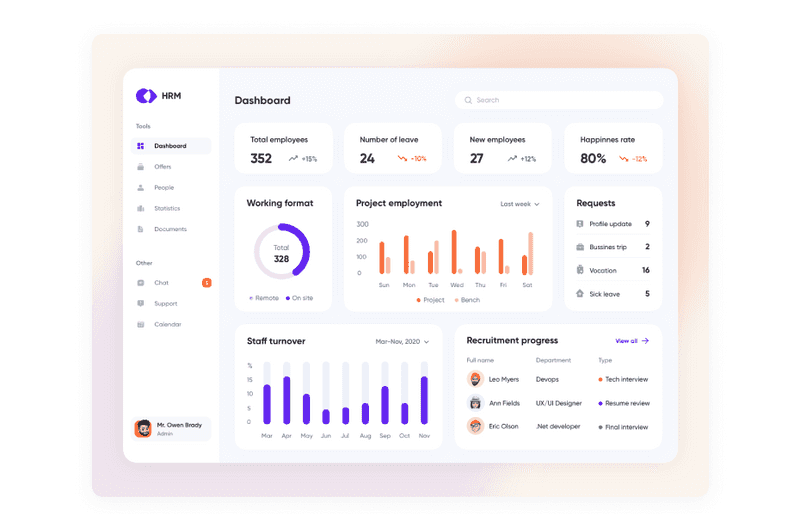
Dribbble shot by Cleveroad
There are a few types of HR system software. Many functions in these HR solutions overlap, such as recruiting, training and development, workforce planning, etc. Therefore, they do not have apparent distinctions. But still, let’s consider what types of HR system software there are.
Types of Human Resource Management Systems
The human resources management system is a general term that includes specific solutions such as HRMS, HRIS, and HCM. Below we will explain the features of each of these abbreviations. But for now, we note that HR systems are usually called start-up solutions to help recruiters in companies from the segment of small and medium-sized businesses.
-
HRIS (Human Resources Information System)
Human resources information systems help HR department workers to automate their routine processes. As an example of process automation, one can cite such a routine of an HR manager as upholding statistics and employee base, drawing up reports, calculating vacations and sick leaves, creating meetings, events, etc.
Therefore, the features of human resource information systems are the basics for all types of HRMS. An example is Eddy HRIS, which offers a wide choice of tools that automate the work of the HR department.
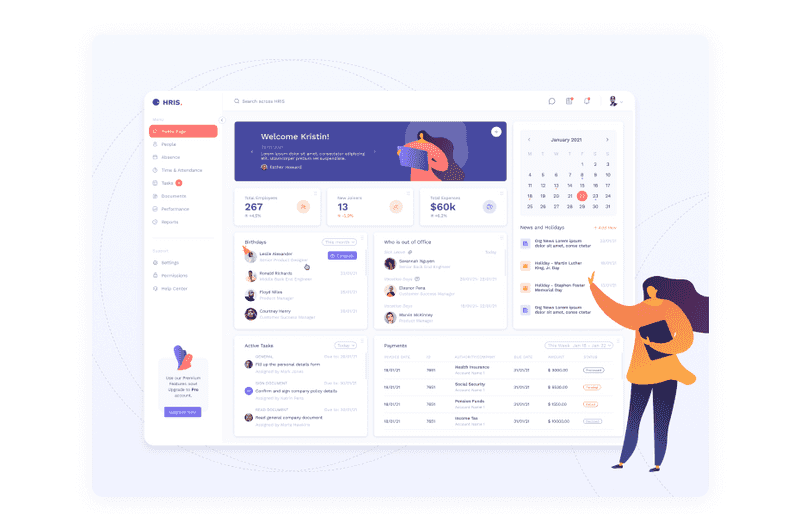
Dribbble shot by Alisa Grosheva
-
HCMS (Human Capital Management System)
This human resources management system has fuller functionality. For example, it can generate salaries (with taxes) and manage employees’ schedules, deadlines, etc. Finally, the example there is Sapling HCMS. This HCMS not only helps HRs to work more efficiently but also has tools for other employees.
-
HRMS (Human Resources Management System)
This one contains all the features that HCMS has. Still, there are hr management tools for talent development, career planning, salary increasing, email automation, data gathering and analysis, etc. An excellent example of this type of HR system is Workday. They offer a wide range of tools that help to manage HR, finances, and employees’ work schedules.
-
HR onboarding software
Such solutions help to onboard new team members, evaluate their progress, and collect information.
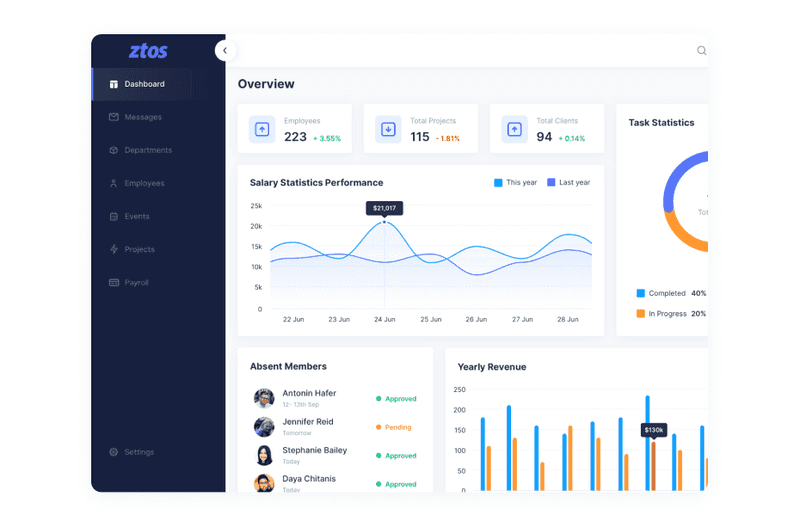
Dribbble shot by Dibbendo Pranto
The primary goal of any type of enterprise hr software is to retain qualified and skilled specialists. In this article, we will talk about HRMS. But what else reasons to integrate human resources management system into business according to the company’s needs?
Reasons to Integrate HRM Software
Human resources management systems help businesses solve many tasks regarding management and recruitment:
-
Cost management
HRMS software helps to plan and optimize costs. For business, it is essential to allocate funds wisely. In addition, the HRM system automates routine work and reduces the number of errors. That is, there may be fewer employees.
-
Efficient business process management
With the help of the HRM system, there will be the ability to automatize many business processes such as payrolling, keeping records about employees, creating motivation plans, etc.
-
Legal compliance
It means compliance with legal norms between the employee and the employer. With the help of the HRM system, it is possible to solve complex issues, such as the introduction of flexible payroll systems and personnel workflow.
-
Employees’ development
With an HR management system, the business can improve employees’ skills with the help of individual development plans. With a human resources management system, you can collect feedback from people and help them develop within the company. And thus create an L&D (Learning and Development) department.
-
Better employee retention
It can be achieved with the help of user-friendly HRMS, which creates a favorable and convenient working environment. Also, with the use of such software, it is possible to collect feedback from employees with the help of which you can improve working conditions in your company.
-
Disposing of errors
Many errors can be eliminated through automation integrations such as AI or ML. As a result, the human factor will no longer affect information analysis.

Now we know the reasons to implement the HRM system into your business. If you want to save employees from unnecessary paperwork and direct their time and resources to more significant tasks, then it’s time to think about it. We know the seasons to implement a human resources management system, but you need to know a few more things. What advantages will your business and employees get if you take this step towards HR digital transformation?
How can the Human Recourses Management System Benefit Your Business?
When it comes to Human Resource Management Software (HRMS), the most common thoughts that come to mind are the costs and complexities involved in implementing the system.
But there are certain benefits that HRMS software can bring to your company, such as saving money on performance tracking and eliminating redundant HR tasks. It will help your company grow and increase professionalism. Let’s take a look at these benefits:
-
A more efficient recruitment process
HRM system can help your HR professionals create job listings and find the best talent by analyzing resumes for keywords. Another benefit is the automation of some of the paperwork to make it easier for you and your team to onboard if that person is hired.
Finally, HRMS software can help you dig deeper into employee analytics and solve hiring problems.
-
Better access to information
Each employee has a personal profile in the HRM system. They can look through their tasks and ask for sick leaves and vacations. And also, you can track their growth in the company, projects, various activities. Yet, you can set KPIs to measure the performance of your employees.
Yet, HRMS software detects all new regulations or laws and data privacy changes. As a result, all your company’s data will be protected and updated automatically and in a better way.
-
Employee self-service
With the HRM system, employees can do simple tasks such as updating their personal information without involving HR managers. As a result, it will free up the HR professionals for more strategic jobs.
-
Accurate time tracking
With the HRM system, it is possible to track employees’ attendance, over time, create timesheets and maintain time clocks. It is beneficial for monitoring remote workers. Yet, every employee has access to this to see how much they have worked. With accurate time tracking, you can see how efficient your employees work and make accurate forecasts regarding achieving any business goals that depend on their work.
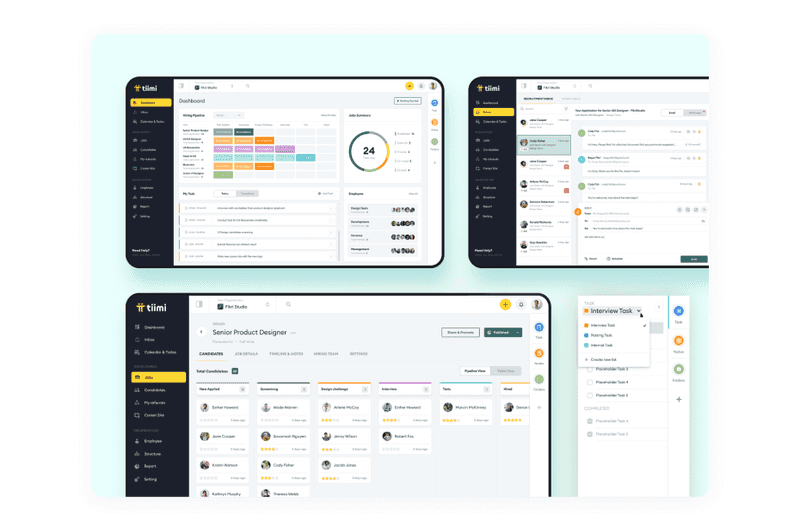
Dribbble shot by Fikri Studio
-
Getting the most out of data analytics
HRM system automatically collects, analyzes, and creates statistics based on the information received. Automation of such processes speeds up work and helps to avoid mistakes that a person could make when calculating. And also, no data will be overlooked.
-
Setting KPIs
A KPI (key performance indicator) is a measurable value that shows how successful employees or businesses achieve goals or finish the task. For example, you can set KPIs for HRs and other employees to see how effectively they work.
-
Optimization of the performance of the employees
The internal HR system allows an employee to track their progress. Based on this data, they can develop their goals and make adjustments and improvements in their work.
HRs and managers also have access to this same information, and with it, they can make suggestions, provide more accurate feedback, and help employees plan goals. Managers can even see employees’ accomplishments before a meeting or between meetings, allowing them to reward good work, which is essential for increased productivity.
-
Go green
With the help of a human resource management system, your business can get rid of paperwork. How? Well, with HRMS, you can send payrolls via direct deposit instead of using paper checks. Or you shouldn’t print out any contracts to put a signature because it can be done right in HRMS software.
One more benefit of it is reducing costs on supplies because you won’t need it anymore. Going green is a trend, so your company will keep up with the time.
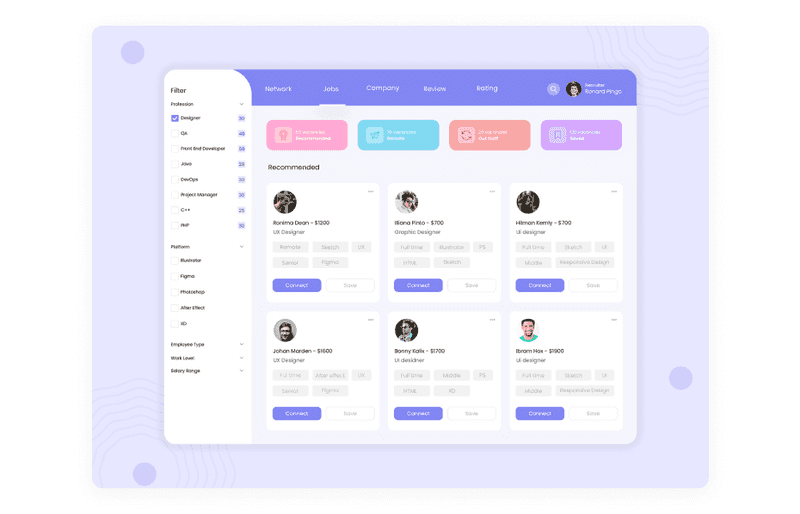
Dribbble shot by Excellent WebWorld
There are many ready-made solutions on the market, but when a custom human resources management system is the best solution for your business? Of course, there are pros and cons to this decision. Let’s see.
When a Custom People Management Software is the Best Solution?
You might be thinking: why should I invest in building a custom HRM system? There is at least one answer. No off-the-shelf HRM software will fit your business perfectly. Every company has its own needs, so if you just buy a ready-made HRM solution, you will have to invest more in the missing integrations. And, most likely, you will need several different services to cover all tasks. What is the point, then?
But if you invest once in a custom human resources management system, you will get a unique product for your business that will fit perfectly. But still, this step also has pros and cons. Let’s take a look at them:
Pros
To begin with, let’s look at the rather significant advantages of custom HRMS.
- A custom people management software would fit your business’ needs perfectly;
- It is a flexible solution for your business, which can always be supplemented and adjusted to new needs;
- HRMS would have a higher security level because only you and your team will have access to the code;
- Such an employment information system can be sold to another business with similar problems and needs. This way you will earn more. Great, isn’t it?
Everything sounds great, but there is also a fly in the ointment. Let’s see the cons of custom HRM software.
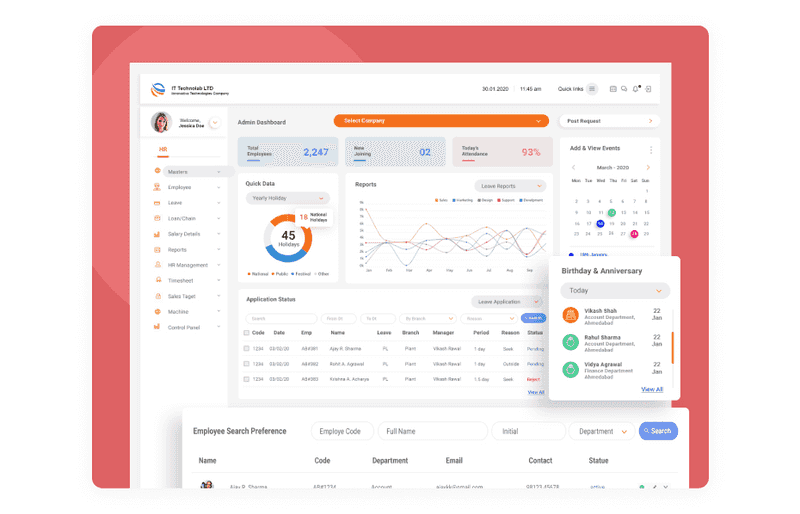
Dribbble shot by Revival Pixel
Cons
To understand if the custom HR system software is the most suitable choice for you, let’s see the cons:
- You need to spend time and money to create and launch your human resource management system;
- You will have to use another HRM solution while you develop your own, and you have to pay for this;
- There may be risks associated with the development or with an inaccurate definition of the necessary features;
- If your business processes turn out to be unsettled, before developing a custom HRM solution, you will first have to work within the company.
Every decision has a downside. There are both pluses and minuses in developing a custom solution, and you must decide for yourself what is more profitable for your company.
So, you have realized that custom HR system software is the way you want to go. But what’s next?
5 Modules of Human Resource Management Systems
HR is a complex responsibility that includes many tasks, from payroll and benefits management to employee recruitment, evaluation, retention, training, and performance management.
Human resources management systems (HRMS) help manage the scope of the HR department’s responsibilities and help to create a happier, more productive workplace. The Transforming HR Through Technology: The Use of E-HR and HRIS in Organizations research has found that human resources management tools can increase service quality, organizational effectiveness, efficiency, and performance.

Dribbble shot by Axicube
A perfect system should have a wide variety of human resources management tools. To make it more understandable, we have divided all features into several groups by functionality: Core HR, Workforce Management, Recruitment Management, Applicant Tracking, Reports and Analytics. Let’s descry every group:
Core HR
Core HR features include general administrative functions that increase efficiency and help managers create happier, more productive teams. So, these features are:
-
Benefits administration
Calculating factors that affect payrolls may take a lot of time. These include pension plans, medical insurance, maternity leave, sick leave, and vacations. Everything should be considered when it is time to calculate the payrolls. With HRMS software, these actions are automatized, so there won’t be a place for errors.
-
Management
This feature helps streamline HR processes by viewing candidates’ applications and resumes, entering performance appraisal data, approving expense claims, accessing employee information, and approving tasks.
-
Self-service portals for employees
With this feature, employees can log into this and fill in or update their personal information by themselves. It would save a lot of time and effort for HR personnel.
-
Company documents management
HR document management system will help you to get rid of paperwork. Moreover, you can easily organize all your documents and share confidential files from a centralized location with this feature.
-
Mobile compatibility
To maximize efficiency, your HR system software should offer solutions on the go. These may be human resource software applications based on iOS or Android. Mobile compatibility allows your employees to access the information whenever they are. It is crucial for Millennials and the Gen-Z workforce because they use smartphones more often.
-
Automated reminders
A good HRMS software should have a function that allows queue reminders about pending tasks. Reminders can also be duplicated to email or smartphone, so no one misses anything.
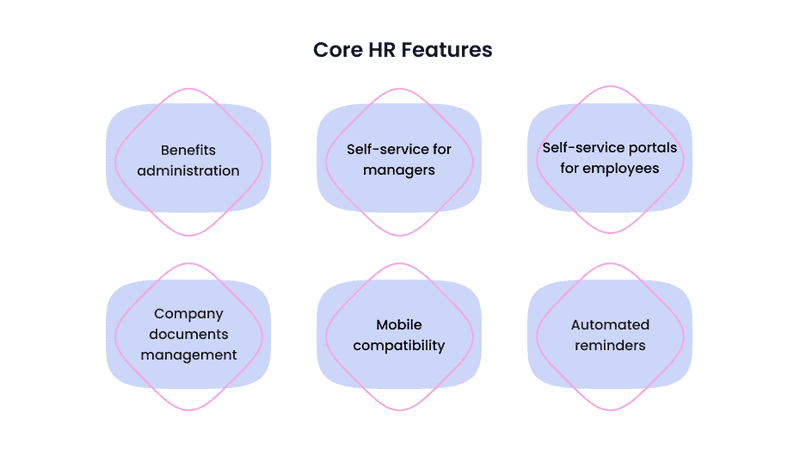
We have analyzed the main features of human resources management systems. As a result, It can already greatly simplify the work in your company and automate many processes. But this is only the tip of the iceberg of all the possibilities of HRM software. Are you wondering what’s next?
Workforce Management
Companies that benefit the most from workforce planning tools are those that pay wages on an hourly basis, work on a project basis, etc. For example, since we are a web design agency and charge our clients by the hour, we use the time tracking feature for our designers.
But if your company is not working on a project basis, you can still benefit from these features of the human resource management system. With them, workers can track their progress and how long it takes to avoid overwork.
-
Attendance management
The attendance feature offers options such as PIN codes, biometric scanners, magnetic card readers, and fingerprint and faces recognition tools. In addition, this human resources management system feature will allow you to track employee attendance. For example, what time did the employee arrive at work? What time did they leave?
Yet, there employees can schedule vacations or ask for sick leaves. It makes it easy for managers to know who’s in and out and for what reasons.
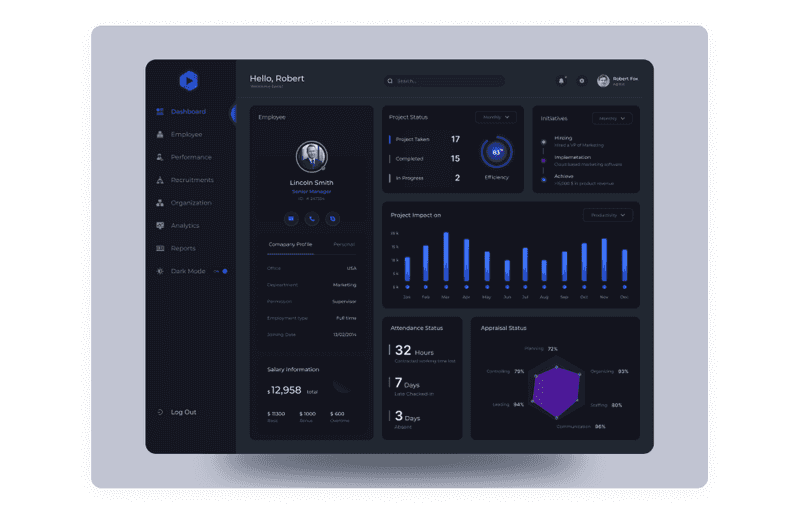
Dribbble shot by Gopal Das
-
Employee Scheduling
This feature allows you to manage employee schedules. It is also possible to set notifications and alerts here that notify employees of changes in the schedule.
-
Accounting for sick leave and vacations
The accounting for sick leave and vacations feature of HRM software helps payroll correctly and know who of your employees may need help because of sickness.
-
Organizational charts
The HR org chart allows a company to keep track of job openings, review which teams are in the company, and see possible gaps in the workforce. Staff organizational charts show all the employees in a particular department or across a business, identifying what they do and to whom they report.
-
Payrolls
Using HRMS software for payroll management allows the integration of attendance and time tracking features with payroll functions. This way, you get accurate data for employees to calculate payroll and employee benefits, all in one holistic system.
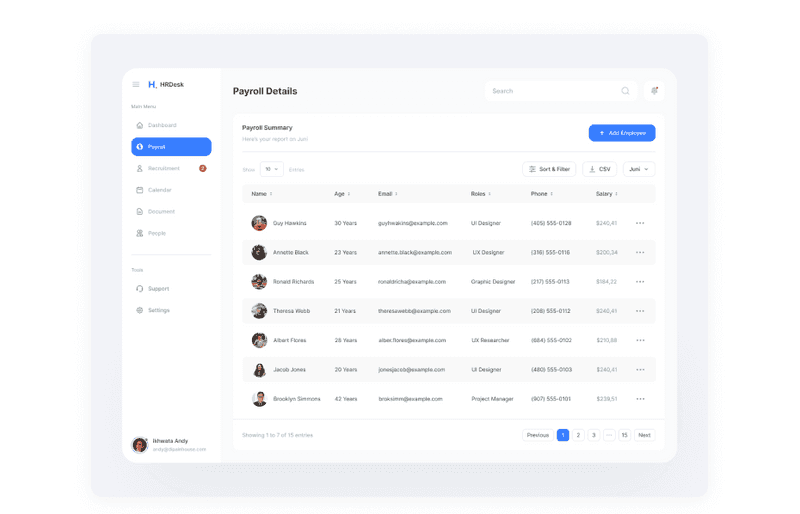
Dribbble shot by Ikhwata Andy
-
Cost estimates
HR software uses HR data to offer time and cost estimation features for various things like paying employees, paying bonuses, or spending money on corporate events, allowing you to predict future resource needs better.
These human resources management system features will make the workflow more smooth. For example, there won’t be any need to spend hours calculating payrolls. Yet, your employees won’t overwork, so that it can increase the happiness level in your workspace. Do you want to unlock other possibilities of people management software? Let’s go!
Recruitment Management
These are maybe almost the most critical features of the human resource management system. Recruiting has a lot to do with sales. Only in this case, recruiters “sell” vacancies and the company, and their leads are job seekers. This is why recruitment software is very similar to CRM.
It also has a database of candidates (leads), the sources you source candidates from (marketing/sales channels), the pipeline that job seekers take through your hiring process (just like a sales pipeline), and the hiring workflow itself ( just like the sales workflow).
-
Automated Recruitment Compliance
One of the essential considerations in the recruitment process is to avoid discriminatory practices. Job postings, reference checks, and interview questions are open to biases based on status, physical and mental disabilities, etc. Your HRMS software can ensure that all communications remain reliable and leave no room for discrimination. Yet, all candidates are entered into a single database without the possibility of discarding any for personal reasons.
-
Candidate Sourcing
There can be several sources: the company website, job sites, social networks, phone calls, etc. In addition, you can use automation to post job ads and accept job applications quickly.
Your human resource management system will also help automatically transfer all applications from potential employees to your system.
-
The Recruitment Funnel
Using this feature, it is possible to automatically email candidates and run them through the recruitment funnel to attract recruiters and HRs already at the screening and interview stage.
-
Candidate Tracking
After collecting the applications, you must ensure that everything goes right and qualified candidates are hired. With workflow automation and checklists, human resources management tools can also make this easier. Checklists are, for example, a list of steps that an HR specialist needs to take in their work on a vacancy.
-
Requirements Database
It refers to the requirements for different positions. For example, what should a junior specialist be able to do, and what should a middle specialist, info about different jobs that recruiters may need.
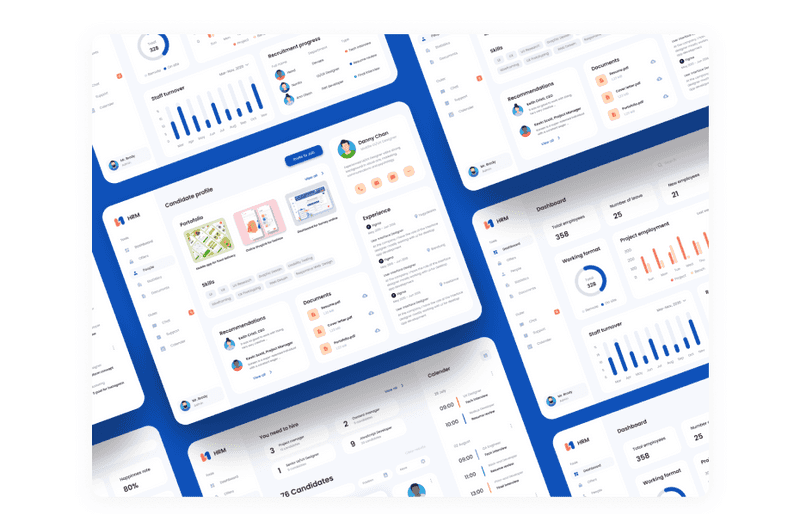
Dribbble shot by Rani Mulyani
With these HRMS software features, the hiring process will run more smoothly, and your HR department workers will be able to focus on other tasks that require attention.
Applicant Tracking
So, HRs have found new hires. But, what onboarding features of the human resource management system are needed to make a great first impression and retain the best talents?
-
Paperless Functions
It means that every form that needs to be filled or a document that needs to be signed is digitalized, so everything becomes paperless. There are now paperless job contracts, tax forms, benefits applications, time-off requests, and more. It is more cost-effective, environmentally friendly, and secure.
-
Gamification Capabilities
It can work significantly on onboarding or performance features of the human resource management system to create a more interactive and engaging work environment.
-
Probation Management Functions
Every new hire goes through a probation period. This feature makes this process run smoothly. The success of the probation period depends on job performance, attendance, and proper conduct. This feature includes goal setting and performance review.
-
Personal Profiles Creation
Here, you can enter information about employees’ work success, professional development and set a PDP plan.
-
Evaluation of Mood and Performance
With this feature, you will always be aware of your employees’ effectiveness and understand whether they are satisfied with everything. Keeping track of this can help in retaining the best employees.
Trust us, with onboarding features like this, your company will make the best impression on interns and new potential employees. Also, with the help of these features, your HR managers can quickly weed out the wrong people and notice the most suitable talents for your company.
Reports and Analytics
A great benefit of HR system software is that it allows collecting data and analyzing it automatically. Let’s see what features of human resource management system help to report and analyze information:
-
Customizable dashboards
It is vital for human resource system software to be customizable to fit the needs of your HR department. This feature includes allowing your employees to create custom dashboards with the ability to change colors and other elements. In addition, it can increase your employees’ engagement with your HRM system.
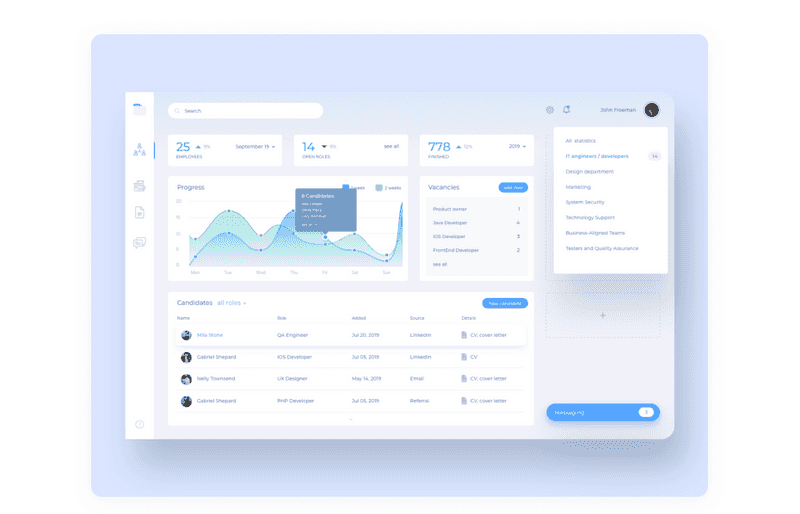
Dribbble shot by Vlad Bulyn
-
Real-time reporting
Your HRMS software should offer tailored and customizable analytics and reports based on your system data. Real-time information and reports enable you to make timely decisions that increase productivity.
-
Automated data-gathering
HRM software will enable you to access any information you require, when you need it, to help you collect the acuities you need. It also contains accessing information and data beyond its database to produce sophisticated reporting.
-
Forecasting
According to desired KPIs, HRM system software can allow you to look back through data and guide future performance. For example, the forecasting feature can help you calculate how many hours a task will require or how many staff members should be assigned for specific tasks.
-
Financial analytics
A good HRM software can gather and evaluate various degrees of financial data to help the business with decision-making processes.
-
Access control
This feature helps to assign levels of access to different resources. Enhancing data security and outlawing information sharing with non-authorized users is needed.
-
KPI tracking
With this feature, you can track the efficiency of the HRs, employees satisfaction, the percentage of dismissal, etc. HR Key Performance Indicators (HR KPIs) are HR metrics used to see how HR contributes to the rest of the organization. This means that KPI in HR measures how successfully HR is implementing an organization’s HR strategy.
Hiring a new employee is an expensive and lengthy procedure: search, screening, interview, onboarding. Then, when a new employee is already in the team, you need to track their mood, progress, etc.
And at every stage, they can quit or simply not show up. With the help of various HR tools, you can hire an employee more efficiently and retain them. Yet, you can reduce the number of layoffs and avoid employee burnout.
With all of these analytical HR management tools, you will be able to think strategically according to data. Isn’t it helpful?
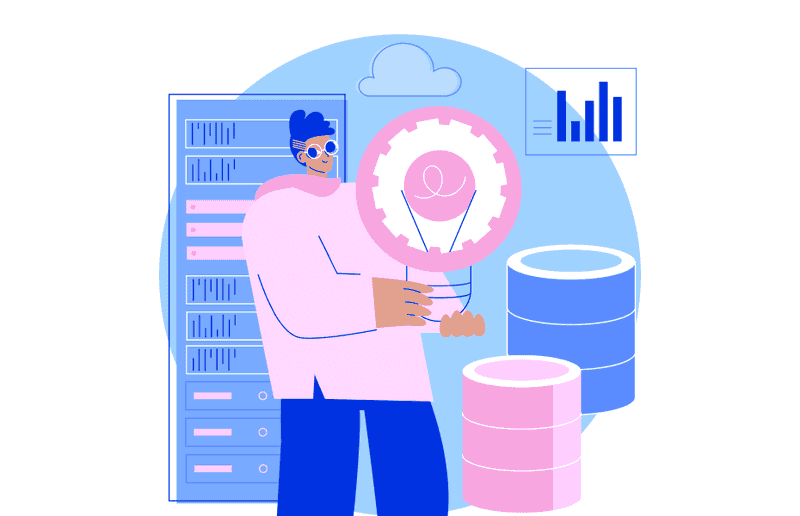
5 Hottest Trends in Human Resources Management Systems
Over the past few years, technology has played a crucial role in changing how HR works. Some exciting and new technological innovations for HR will help recruit, attract, and retain talent.
-
RPA
RPA, also called robotic process automation, uses robotic technology to automate various repetitive tasks. HR processes simplified with RPA include employee relations, recruitment and hiring, training and development, benefits and compensation, and general HR operations.
As a result, this leads to increased productivity and efficiency of various HR department activities and helps avoid errors.
-
AI
51% look to AI to save costs with HR. Artificial intelligence can automate some repetitive tasks, leading to significant savings. According to research from the International Research Journal of Engineering and Technology, Artificial Intelligence (AI) integration into human resources management systems will make organizations better because these applications can analyze, predict and diagnose. So, HR teams make data-driven decisions.AI can help in analyzing performance data to choose the most suitable candidate. Then, when the candidate is chosen, artificial intelligence can ease the onboarding process. But it is helpful not only for newbies in the company. It can also be implemented into a chatbot.
“Chatbots can provide a natural, human-like, and always-on communication tool that engages the user in personalized conversations,” Michael Cohen, chief product officer at Achievers, says. “These conversations are then analyzed and leveraged to address the employee’s specific concerns, wants, and needs. But it doesn’t end there. The action after the conversation is just as critical as asking for feedback in the first place.”
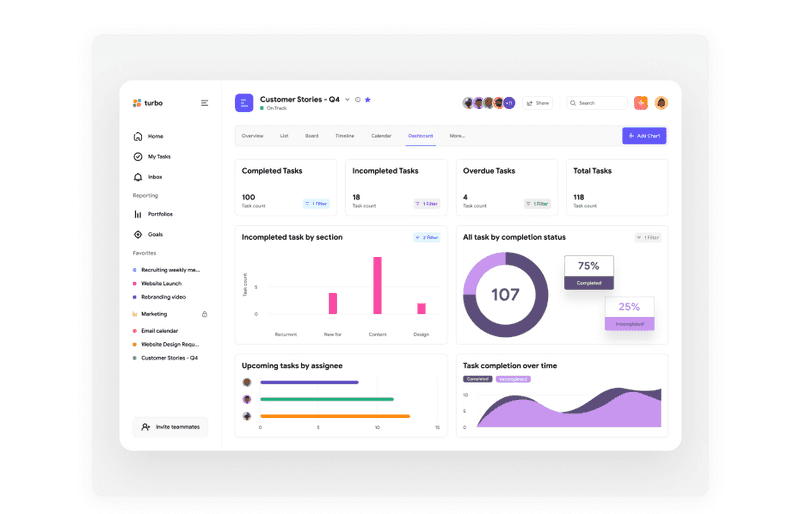
Dribbble shot by MidInventory
-
VR
Virtual reality helps not only companies but also candidates. For example, virtual reality can allow a candidate to have a virtual experience of being in an organization during the day. The candidate will meet other employees managers and even launch a project. But, most importantly, the candidate is well acquainted with the office culture.
Where else can VR be applied? Learning and development is one such area that can benefit the most from virtual or augmented reality. This technology trend can take skills acquisition and employee training to a whole new level.
For example, if you want your recruit to become proficient in public speaking, you don’t need to enroll in an expensive public speaking course at some famous school. Instead, the virtual trainer can do all this within your HRM system.
Yet, you can bring your team building to a new level with this technology if we talk about remotely working employees.
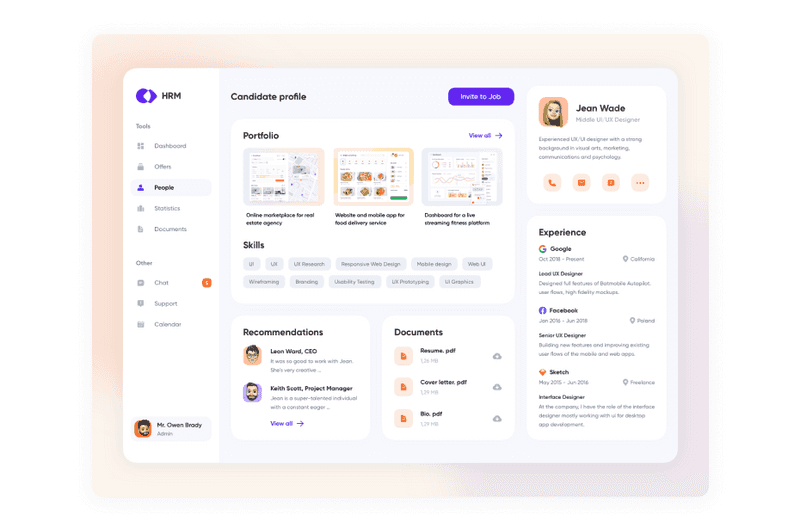
Dribbble shot by Cleveroad
-
Social media
According to Open University, 79% of job applicants use social media in a job search. For human resources management, social media have become a great tool. HR managers can skim through pools of talents on social media platforms with just a few clicks. They can also run their recruitment campaigns on popular social. That’s why it is essential to implement it in your HRM system.
-
Gender sensitivity
Using technical human resource software applications such as AI (Artificial Intelligence), ML (Machine Learning), and a strict HR policy give the ability to track women’s progress through learning management systems. As a result, in-place succession planning will close the gender gap in business once and for all.
Gender equality prevents injustice against women and girls. It is essential for economic prosperity. Societies that value women and men as equals are safer and healthier. It’s also great when the HRM system can use gender-neutral pronouns and words so that every employee can feel comfortable regardless of gender.
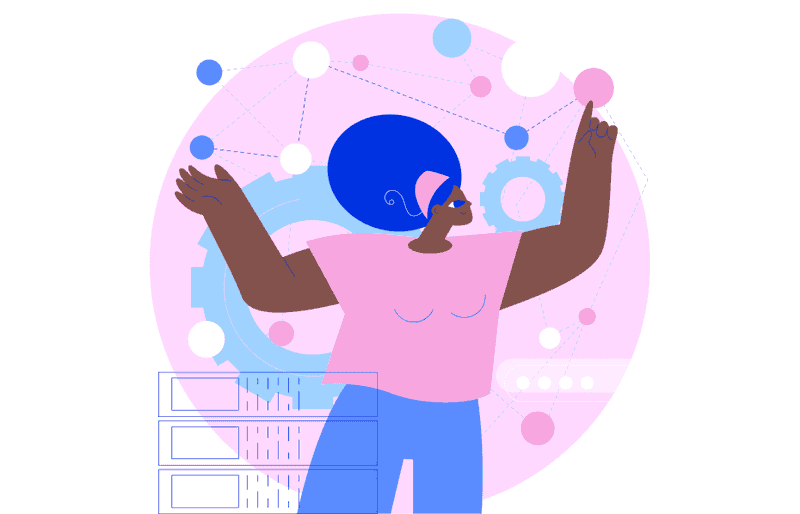
After we have defined even the hottest trends in HRMS, it is time to find out how to create HRM system software. Ready?
How to Create an HR Management System?
To create a personnel management system, you need to go through a few steps. In our previous article, we’ve talked about typical steps for creating digital products. Read it to find more information about the process.

How Do the Perfect Design Process Steps Look? Everything You Need to Know
Today, we will overview the general activities needed to make a personnel management system. So, where do you begin?
Specify the Goal and Concept of Your Future People Management Software
When planning hrm software development, it is essential to remember that it is not a goal itself but a tool to achieve your business goals. To make it, you need to understand all HR department processes in your company.
To understand how you can improve the hiring process (or another point in your business), you can use a schematic map of business processes. It will help you visualize all the stages of recruiting, solutions and tasks, the persons involved. This makes it easier to analyze the business process to identify bottlenecks that can be optimized using human resource system software.
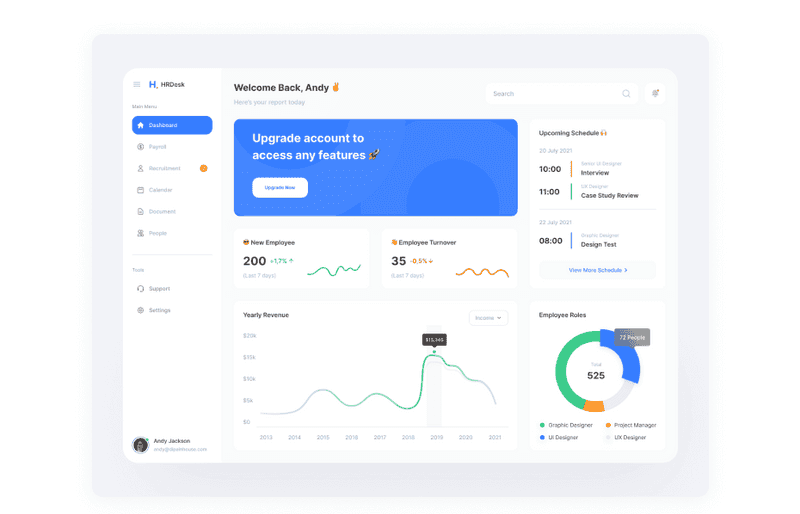
Dribbble shot by Dipa Inhouse
To map your business processes, you need to talk to your HR team to understand how their processes are going and if everything is running smoothly. If their workflow is chaotic, you need to bring it to a single sequence and then think about what features can be used to improve and speed it all up.
With this understanding, you’ll be able to identify the main features that are vital for your company. The next step is creating an MVP model.
Define MVP Before Starting HR Software Development
Human resource software solutions have six modules: core, workforce management, recruitment and/or tracking systems, and learning management and analytics. However, you do not have to implement all of them when developing your human resource management system. Instead, you can create only a few modules and add the rest as needed.
So, creating a minimum viable product (MVP) allows your business to test an internal HR system idea and evaluate its validity or failure. To make it, list all must-have features. Then, when your MVP is defined and tested, you can move to the project’s next phase.
Develop a Vision of the Future HRM Software
The vision of your future HRM system is all about design. But, of course, functionality is a priority for the users – and that’s true. The human resource management system should solve the problems of your business and your employees effectively and quickly. But what’s next? You and your workers will use the internal HR system frequently, so the aesthetic pleasure and emotional appeal should also be there.
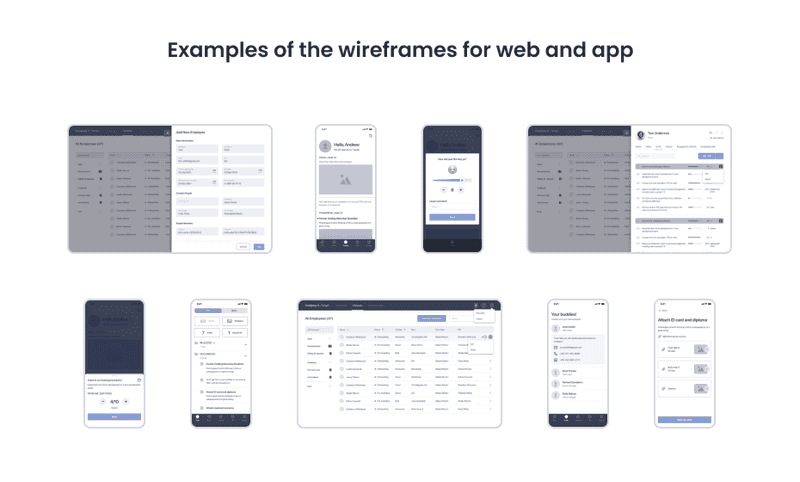
Examples of the wireframes by Axicube
What makes aesthetics? UI (User Interface) design includes screens, buttons, pages, and other visual elements that help users interact with your HRM system. UX (User Experience) aims to provide a positive experience when users interact with the app. To make a good user experience, you need to answer some questions: “which operations do you want to streamline?”, “what features do your HR colleagues need to work more productively?”. The answers to these questions will give you a clear picture of how the system should function to bring the best result to employees and HR specialists.
The UI/UX design is vital for an HRM system because it creates an emotional connection. During this phase, you also get a visual prototype of the end product. After this stage is done, you need to test your hypothesis.
Test it!
Prototype testing is a significant part of the design process. Testing and evaluation confirm that the product will perform as planned. Or otherwise, testing helps identify potential bugs, allowing developers to make improvements before the launch.
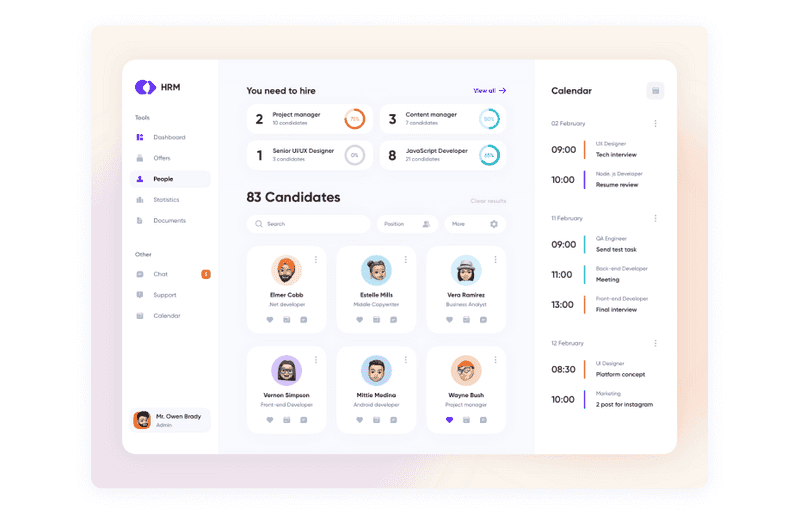
Dribbble shot by Cleveroad
In general, prototype testing allows the designer and client to assess the viability of the design. For example, will the HRMS Software be successful? Is it meeting its goals? If it turns out that the prototypes are not successful, the previous steps can be repeated again and again until perfection is achieved.
How to Apply HRMS Software to Your Business and What Challenges You May Face
Creating the perfect internal HR system is only the first step of your journey. At this step, your human resources management system is only potentially perfect. Everything depends on the installation and implementation. And this brings some challenges such as:
-
Data
Here the challenge is to move the data into HRMS. Perhaps you had a different solution before, or there was no HRM at all. After that, test everything, including core functionality with your data and navigation, integration with other software (ERP, CRM), and critical reporting.
-
Configuration
Perhaps the created custom human resources management system is exactly what your company needs - plug and play. However, it is also possible that your HRMS implementation project will include reviewing your HR procedures. You may need to change the steps in the workflow, streamline them, or tweak them a little to fit the new system. In any case, employees will need time to get used to the new system.
-
Security
According to statistics, 41% of companies have more than 1,000 unprotected sensitive files (inc. credit card numbers and health records). And the average cost of a malware attack is $2.4 million. Of that cost, 43% is down to the loss of information.
The risk factor can be in mobile access. The flow of data between users’ devices and your human resources management information system (whether in the cloud or not) is an opportunity for a cyber-attack. To reduce it, you can consider using data leak prevention solutions like UpGuard.
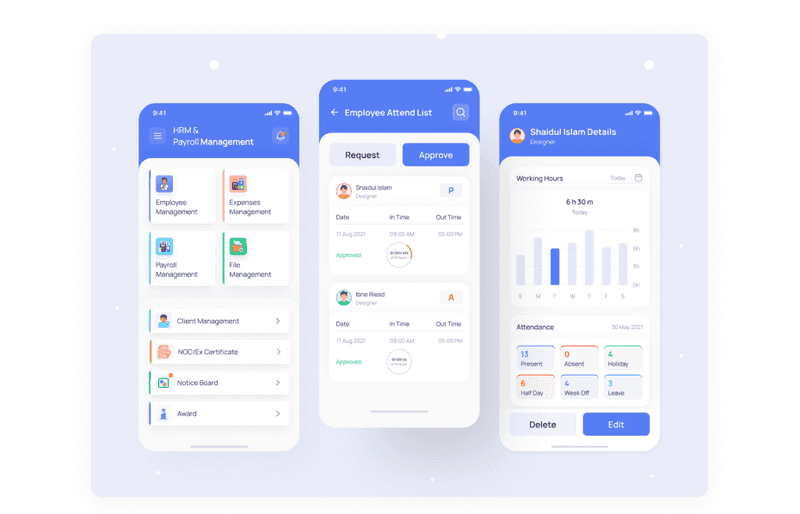
Dribbble shot by MaanTheme
-
Scalability
Your new HR management information system may be significant and suitable for your business, but what will be in five years? It should be able to adapt to unique business needs. When developing a personnel management system, take care of this issue.
-
User training
Consider the different needs of your employees. For example, the needs of the HR department are different from the needs of employees from other departments. In addition, different people respond best to different ways of getting the information they need.
You may need to consider various training methods, including face-to-face training courses, online distance learning, online tutorials, or advanced users who can train their colleagues as needed.
Implementing a new employees information system often comes with some challenges. Regardless of the size of your business or the extent to which you plan to automate your workflows, the above HRMS implementation challenges can get in your way. Ignore them to benefit the profits that you will receive in the end.
Conclusion
A HRM software is a must-have tool to improve your company’s recruitment processes and employee management. It will give you many benefits that would skyrocket your employees’ workflow and make it easier to achieve business goals.
With a custom HRMS, your business will get the most suitable solutions with only needed and useful features to streamline all processes. As a result, your HRs will find the most suitable talents for your company, and employee retention will increase many times. Of course, there are some challenges on the way, but it is worth it.
If you plan to launch a personnel management system software project, the Axicube team will be happy to help you with this. With our help, your business will get an effective HRMS that will not only speed up and simplify the work of your employees and HR department but also look attractive. After all, designing and creating a great user experience is what we do great.


